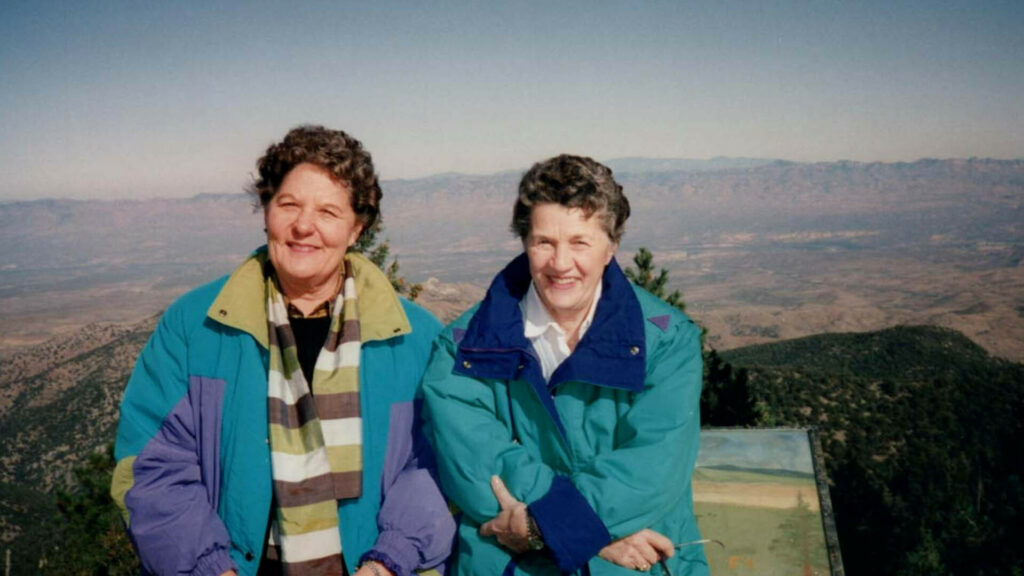Shhh: Pat and Terry kept their relationship a secret for decades for fear
of reprisals from the state, family and colleagues. Photo: Netflix
Pat Henschel and Terry Donahue are cousins and roommates. Their house is neatly cluttered with floral couches, empty supplement containers, paintings, rocking chairs, fine china, decorative ceramics, quilts, books and records. It’s clear that Pat and Terry have been very close for many years.
 Protective fiction: Pat Henschel and Terry Donahue feature in the documentary A Secret Love, directed by the latter’s great-nephew. (Netflix)
Protective fiction: Pat Henschel and Terry Donahue feature in the documentary A Secret Love, directed by the latter’s great-nephew. (Netflix)
In every room, tabletops and bookshelves are decorated with countless framed photographs of the two of them over the years. After sharing the house for more than 26 years, the pair has grown too old to maintain a home of that size. So they’ve begun looking for a retirement village to safely grow old in. “I don’t care where we go. As long as we’re together, we’ll be happy,” Terry says. Directed by Terry’s great-nephew, Chris Bolan, A Secret Love tells the story of a white lesbian couple who managed to keep their relationship in the shadows — away from family and colleagues — for seven decades. Over the course of five years (2013 to 2018), Bolan followed his great-aunt and her partner as they debated the conditions of moving into a retirement facility and getting married.
Through this plot, A Secret Love spends time in the couple’s intimate present and past to find out why they have kept, and continue to keep, their love a secret from many people. A Secret Love does not feel like a documentary in which interviews are used to report on an event, subject or person. Instead the director lets their story unfold with little interference from interviewers. The audience learns more about the couple by listening and watching them interact and reminisce with loved ones about their love. By so doing, the couple appears to maintain agency in portraying their narrative.
“In the ’40s, you had to be very careful,” says Terry. During World War II, patrols would often raid bars that were suspected of being a safe space for queer folk as a part of what was then referred to as “moral drives”. Women who were found to have fewer than three articles of what was considered “women’s clothing” were arrested. Their names, addresses and occupations were then published in local newsletters and papers: this led to unemployment and the increased threat of corrective rape. In their homes, they feared being cut off by parents and siblings.
With this knowledge about how their sexuality would affect their quality of life, Pat and Terry avoided all public encounters with the LGBTI+ community. To fill these experiential gaps, A Secret Love adds to the couple’s story through interviews and archive material. For example, when they speak about the legislation against queerness the documentary makers insert an interview with former gay bar owner and activist Marge Summit shortly before a speech in which detective John Sorenson, from the morals and juvenile squad of Florida’s Dade county, threatens a group of women about their decision to “turn lesbian”. The inclusion of such material expands the couple’s personal picture into one that makes the audience aware of the foundation that their relationship, which began in 1947, was built on.
Many decades later, the United States has reformed legislation to include gay rights. Although their relationship is now legal, Pat and Terry continue to operate within the boundaries they used when their relationship began. To this day, Pat and Terry still refer to each other as “cousins”, there are only two encounters when they kiss in the presence of cameras, and all the love letters they wrote to each other stay hidden just in case they have company over. These boundaries are apparent even in their language. Apart from one incident, neither the couple, nor their loved ones, outwardly refer to them as queer, lesbian or gay. In the place of these terms they use euphemisms like “this way” or “that way” to refer to Terry and Pat’s sexuality.
By tracking their relationship from the 1940s to the 2010s, A Secret Love is a faultless testimony to the survival of white queer romance.
With their love making it through all those years, in spite of homophobic push back, the documentary attempts to paint the protagonists as overcomers and heroines worth celebrating, especially with Netflix releasing the documentary shortly before Pride Month.
However, Pat and Terry’s queer love story lacks global resonance because it is devoid of black counterparts and concerned only with itself. If anything, it highlights how black queerness has been portrayed in contemporary pop culture. White queer love has a celebratory reference such as A Secret Love; black queer love has archives of resistance and survival like Paris is Burning (Jennie Livingston), The Death and Life of Marsha P Johnson (David France) and Difficult Love (Zanele Muholi).
There’s a gap in the market for true stories about Terry and Pat’s black counterparts. Until then, we work toward making a world safe and reformed enough to acknowledge and celebrate black queer love as much as it does black queer pain.